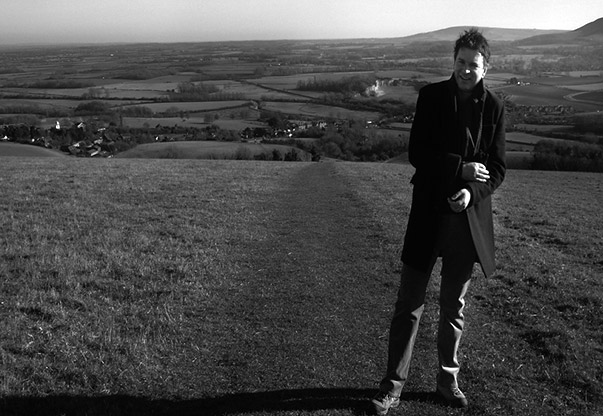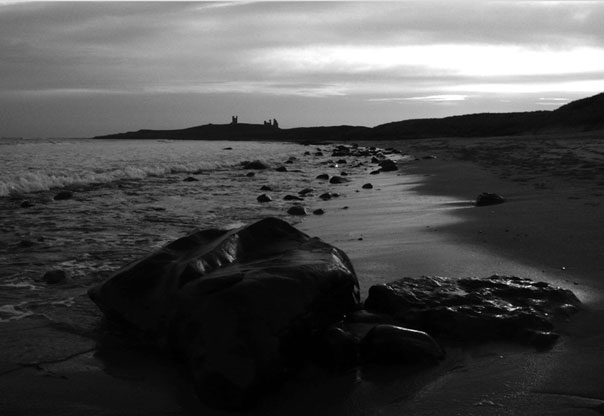My process: Intaglio, influences & inspiration
Thursday, May 15th, 2014
Based on an interview with Christopher in May 2014. Having just been accepted as a guest artist at The Biscuit Factory in Newcastle, and about to have work publicly displayed in the Royal Pastel Society Annual Exhibition, Christopher was preparing for his first solo show.
Buyers often ask me about the various processes and techniques I use to produce my prints and gravures. Most often I’m asked about my influences, my non–toxic approach and the specific steps I take to create new editions. I hope this gives a good insight into the methods I use and how I run my studio.
On location
Several times a year, I relocate for a few days to what I like to call my ‘man-cottage’ on the island of Lindisfarne which is off the wild coast of Northumberland. This former fisherman’s cottage is the base for all my Northumbrian work. I choose all my locations before I start my trip by using Google Maps to pinpoint specific viewpoints to maximise my time there.
I get up early each morning and once at my chosen location I use sketch books, photography and sometimes film to record as much information as possible.
At the studio in East Sussex
Once back at my studio in East Sussex, I assess all my prep work from on location and then start the final graphite drawings. An A3 drawing will take a week to complete. I decide once the final drawings are complete whether it will become an etching or be sold as an original drawing.
For the etchings I scan the original drawing onto my Mac and output the image on to acetate to create a transparency. The polymer etching plate is first exposed with an aquatint screen and then exposed with the transparency with UV light. This etches the drawing on to the plate. The plate is then developed in water, dried and is then ready for the printing process. The plates are then inked, wiped and, along with dampened handmade printmaking paper, pulled through my intaglio press to produce the handmade etchings. Once I am happy with the first artists proof I will start the limited edition print run.
Drawing
I’ve actually had to teach myself how to draw again and especially in terms of skies, I had to quickly develop some advanced skills. I always laugh about the fact that as a kid I used to do drawings of Yorkshire and Northumberland villages and sell them at local fayres, but as I wasn’t confident in those days with drawing skies I always left them blank. Fast forward 40 years, and for all my skies, I draw, building up the layers of graphite pencil and using blending tools and erasers to create each sky. I buy all of my drawing materials from L.?Cornelissen and Sons in London which has been supplying artists since 1855.
Artistic influences
The artists that have had the most influences on my work were the drawings and mezzotints of John Constable, the watercolours of Thomas Girtin and most of the work by William Turner. My photographic heroes were the fine art photographers Steichen, Stieglitz and Sudek.
Printmaking influences
The two printmakers I admire are Norman Ackroyd RA and Emma Stibbon RA. They both work mainly in black and white as I do.
Inspirational locations
For me, the most inspirational places are to be found on the romantic Northumbrian coast — especially from Craster up to Berwick–Upon–Tweed. I fell in love with this area as a child, spending family holidays and weekends there. It has been a massive influence because it’s got everything — ruined castles, the sea, wild moorland, wild coastline and of course the ever–changing weather. I see beauty wherever I go in the British Isles, and especially when the weather is stormy. Most people would be heading for cover, but I love it. I find it so much more interesting as a landscape artist when the weather is at its worst.
The importance of branding
My background is in advertising so it’s really helped to have a knowledge of branding. I’ve promoted the brands of the two companies I’ve started successfully, so as a printmaker it’s important to realise that you have to build a brand. I use a logo, and take care to choose beautiful paper for wrapping prints, decorating them with labels. I wrap each print beautifully in black envelopes as I want people to feel that they’re getting something special in the same way as if they bought a handmade book.
The white butterfly motif
I use a white butterfly as a motif. Not all the prints include one, but you’ll find one in every drawing. Everybody knows about it now and collectors enjoy the whole thing about trying to find them. I’ve been obsessed with white butterflies for decades and I suppose it signifies a remembrance of my Dad who was a great artist, but who unfortunately didn’t fulfil his promise.
The Biscuit Factory
I signed a contract with the Biscuit Factory for 12 months in March 2014 and it’s great to have a presence in a cool Newcastle gallery. It has three floors of the work of local artists. I’ve got six prints up there. It feels like a landmark to get into a gallery in my hometown. The Biscuit is an upcoming place for art and it’s run by lots of young people. They have a good cross–section of work including painting, printmaking, sculpture and pottery. It’s in Byker which used to be very run down when I was a kid, but now, along with the Ouseburn Valley, is a great example of good urban renewal with small independent galleries, businesses and affordable housing
Future work
After preparing 45 pieces of work for my first solo show in October my next big project will be a whole new series of work which includes drawings, etchings and photogravures from the shoreline of the River Thames from Rochester in Kent right through London to Richmond–Upon–Thames. It will include lots of iconic buildings and bridges from the last three hundred years.




